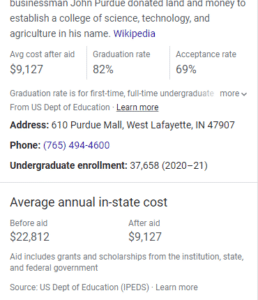Innovating Enrollment: UVM’s Bold Approach to Affordability & Retention
How UVM is innovating enrollment with affordability, leadership, and retention strategies that align mission with measurable impact.
content marketing
Student-centric content has emerged as an SEO linchpin for higher ed institutions that want to connect with their target audience.
Prospective students have a lot of schools to pick from.
And this paradox of choice can be incredibly frustrating when enrollment websites and other school-related media neglect to answer students’ pressing concerns.
Optimizing your content with specific key phrases and links is important, but that only helps to get students and their parents through your website’s front door.
Driving people to your enrollment website is pointless if you don’t have easily discoverable student-centric content that answers their questions.
Every prospective student has a unique background and goals, but I can guarantee that these three questions are on each of their lips when they come across your website:
So let’s dive into how your content marketing strategy should address these three pivotal talking points.
Prospective students come from a rich array of diverse circumstances and cultures.
It’s one of my favorite things about working in higher ed marketing.
Yet, while college is a time for exploration and self-discovery, your students are still looking for a place where they belong.
While no institution is the end-all-be-all for every type of student, I still see schools trying to advertise themselves as such with generic mission statements and values.
Your brand messaging should be targeted toward a mission-fit audience that parallels your school’s mission.
And ideally, prospective students should be able to decide if your school is the right fit before they even get past your home page.
Sterling College in Vermont is a great example of this type of student-centric content.
Sterling is a small private college that promotes ecological harmony in all of its program offerings.
In one short paragraph right on their home page, they immediately filter the type of student they’re looking for:
From just those talking points, the reader can identify if they’re a fit for Sterling without digging through a single tab on the site.
I’d say that’s pretty effective student-centric content.
Regardless of your school’s educational offerings, some of the global questions you should be answering in your at-a-glance content include:
And use student testimonials! People trust people, so students love to hear from other students who’ve experienced life on your campus.
By giving prospective students a multi-dimensional view of your campus, your student-centric content will effectively engage the audience you want.
A lot of new students don’t have a strong sense of what career path they want to take, but most have a general idea.
So, of course, the next thing they’ll want to know is if you have their preferred major.
Unfortunately, a big problem with a number of college websites is that these pages are disorganized or hard to find. They often reflect the college catalog rather than the prospective student’s needs.
Instead of a comprehensive list, majors are buried in departmental pages.
For instance, if you have a prospective student interested in a career with the FBI, they’ll probably want to look for a Criminal Justice major on your website.
But if your Criminal Justice information is fighting for air on your Sociology Department page buried in the School of Psychology section of the website, your audience will struggle to find it.
Instead of organizing information on majors and their programs around faculty and the course catalog, build it around your students.
Not only should your majors be discoverable, but you need to differentiate them from the competition.
Showcase your popular programs’ possible career paths and alumni success stories.
Also, highlight community and industry connections, as well as the hands-on learning opportunities that come with those.
This enrollment-focused student-centric content will not only assure students of the availability but also the legitimacy and potential outcomes of their desired major at your school.
Students — and parents — want a clear picture of what they’ll be paying for and how much.
Those of us in higher ed understand that most students will receive free aid (scholarships, grants, etc.). And with their financial aid package, they won’t pay the full “sticker price.”
But it’s critical that higher ed marketers not assume that your target audience is aware of those opportunities.
Picture this scenario:
An excited high school senior is scrolling through your website with their parents. The senior is talking up one of your flagship programs, and the parents are delighted.
But then they scroll past your tuition’s sticker price, and… yikes. The mood gets a little somber, and the parents suggest their child look at other options
If your school offers affordable pricing options for lowering tuition, lead with that before addressing the sticker price.
I love how Google breaks this down with a simple search of the cost of tuition by school. While it isn’t perfect (utilizing data that may be slightly dated), it does remove the mystery for students and gives you an opportunity to frame the conversation around your website.
For example, after searching “cost of tuition at Purdue,” Google shows me the IPEDS data for the average in-state tuition for both “before aid” and “after aid.”

If the world’s largest search engine can lead with a snapshot of a school’s discount rate, then you should be doing the same on your website’s tuition page.
Maybe you’ve got great resources for scholarships and grants, but they’re buried on your Financial Aid page.
And perhaps your students’ average discount rate after aid is somewhere in there, too.
By not leading with affordability, you risk losing leads who haven’t considered alternative means of financial aid.
So shout it from the rooftops!
The power of student-centric content is in its ability to address the immediate concerns of prospective students:
If you can answer those three questions, you’ll give your audience reasons to stick around and learn a little more.
And if you’ve stuck with me this long, I’d love to continue the conversation around student-centric content with you.
Connect with me, and let’s discover how to take your school’s content marketing strategy to the next level together!
You’re in luck! We’ve curated 25 awesome ideas inspired by top higher ed institutions across the country and put them in one handy guide: 25 Ideas for Great Admissions Content.

Get inspired.
Get enrollment results.
Get 25 Ideas for Great Admissions Content.
Download your copy today!
Featured image by Drazen via Adobe Stock
Subscribe to The Higher Ed Marketer podcast today!